z = c(7, 6, 5, 8, 9, 4, 5, 5, 4, 6, 7, 8, 5, 6, 5)
mean(z)해당 자료는 전북대학교 이영미 교수님 2023고급시계열분석 자료임
CH 05, 06
1
다음의 시계열 자료 ${7, 6, 5, 8, 9, 4, 5, 5, 4, 6, 7, 8, 5, 6, 5 }$에 대하여, SACF, \(\hat ρ_h (h = 1, 2, 3)\)과 SPACF, \(\hatϕ_{kk} (k = 1, 2)\)을 직접 계산하여라. 그리고 유의수준 \(α = 0.05\)에서
\(H_0 : ρ_h = 0 \text{vs.} H_1 : ρ_h ̸= 0\)
대하여에 대한 가설검정으로 하여라.
- \(\hat \rho_k\) 구하기
h=0
\(Z_t= \{7, 6, 5, 8, 9, 4, 5, 5, 4, 6, 7, 8, 5, 6, 5 \}\)
\(Z_{t+h}= \{7, 6, 5, 8, 9, 4, 5, 5, 4, 6, 7, 8, 5, 6, 5 \}\)
\(\bar Z_t = \bar Z_{t+h} = 6\)
(z-mean(z))*(z-mean(z))- 1
- 0
- 1
- 4
- 9
- 4
- 1
- 1
- 4
- 0
- 1
- 4
- 1
- 0
- 1
sum((z-mean(z))*(z-mean(z)))sum((z-mean(z))*(z-mean(z)))/length(z)\(\hat Cov(Z_t- \bar Z, Z_{t+h} - \bar Z_{t+h}) = \hat Cov(Z_t- \bar Z, Z_{t} - \bar Z_{t}) = \dfrac{32}{15} = 2.1333333\)
h=1
\(Z_t= \{7, 6, 5, 8, 9, 4, 5, 5, 4, 6, 7, 8, 5, 6, 5, 6 \}\)
\(Z_{t+1}= \{6, 5, 8, 9, 4, 5, 5, 4, 6, 7, 8, 5, 6, 5, 6, 7\}\)
z = c(7, 6, 5, 8, 9, 4, 5, 5, 4, 6, 7, 8, 5, 6, 5)
z1 = c(6, 5, 8, 9, 4, 5, 5, 4, 6, 7, 8, 5, 6, 5, 7)z-mean(z)- 1
- 0
- -1
- 2
- 3
- -2
- -1
- -1
- -2
- 0
- 1
- 2
- -1
- 0
- -1
z1-mean(z)- 0
- -1
- 2
- 3
- -2
- -1
- -1
- -2
- 0
- 1
- 2
- -1
- 0
- -1
- 1
(z-mean(z))*(z1-mean(z))- 0
- 0
- -2
- 6
- -6
- 2
- 1
- 2
- 0
- 0
- 2
- -2
- 0
- 0
- -1
sum((z-mean(z))*(z1-mean(z)))+1\(\hat Cov(Z_t- \bar Z, Z_{t+h} - \bar Z_{t+h}) = \hat Cov(Z_t- \bar Z, Z_{t+h} - \bar Z_{t+1})= \dfrac{3}{15}\)
h=2
\(Z_t= \{7, 6, 5, 8, 9, 4, 5, 5, 4, 6, 7, 8, 5, 6, 5, 6 \}\)
\(Z_{t+2}= \{5, 8, 9, 4, 5, 5, 4, 6, 7, 8, 5, 6, 5, 6, 7, 6\}\)
z = c(7, 6, 5, 8, 9, 4, 5, 5, 4, 6, 7, 8, 5, 6, 5)
z2 = c(5, 8, 9, 4, 5, 5, 4, 6, 7, 8, 5, 6, 5, 7, 6)(z-mean(z))*(z2-mean(z))- -1
- 0
- -3
- -4
- -3
- 2
- 2
- 0
- -2
- 0
- -1
- 0
- 1
- 0
- 0
sum((z-mean(z))*(z2-mean(z)))+0+0\(\hat Cov(Z_t- \bar Z, Z_{t+h} - \bar Z_{t+h}) = \hat Cov(Z_t- \bar Z, Z_{t+h} - \bar Z_{t+2})= -\dfrac{9}{15}\)
h=3
\(Z_t= \{7, 6, 5, 8, 9, 4, 5, 5, 4, 6, 7, 8, 5, 6, 5, 6 \}\)
\(Z_{t+3}= \{8, 9, 4, 5, 5, 4, 6, 7, 8, 5, 6, 5, 6, 7, 6, 5\}\)
z = c(7, 6, 5, 8, 9, 4, 5, 5, 4, 6, 7, 8, 5, 6, 5)
z3 = c(8, 9, 4, 5, 5, 4, 6, 7, 8, 5, 6, 5, 7, 6, 5)(z-mean(z))*(z3-mean(z))- 2
- 0
- 2
- -2
- -3
- 4
- 0
- -1
- -4
- 0
- 0
- -2
- -1
- 0
- 1
sum((z-mean(z))*(z3-mean(z)))+1+0-1\(\hat Cov(Z_t- \bar Z, Z_{t+h} - \bar Z_{t+h}) = \hat Cov(Z_t- \bar Z, Z_{t+h} - \bar Z_{t+3})= -\dfrac{4}{15}\)
\(\hat acf(1) = \dfrac{\hat Cov(Z_t- \bar Z, Z_{t+1} - \bar Z_{t+h})}{\hat Cov(Z_t- \bar Z, Z_{t} - \bar Z_{t+h})}=\dfrac{3/15}{32/15}=\dfrac{3}{32}\)
\(\hat acf(2) = \dfrac{\hat Cov(Z_t- \bar Z, Z_{t+2} - \bar Z_{t+h})}{\hat Cov(Z_t- \bar Z, Z_{t} - \bar Z_{t+h})}=\dfrac{-9/15}{32/15}=-\dfrac{9}{32}\)
\(\hat acf(3) = \dfrac{\hat Cov(Z_t- \bar Z, Z_{t+3} - \bar Z_{t+h})}{\hat Cov(Z_t- \bar Z, Z_{t} - \bar Z_{t+h})}=\dfrac{-4/15}{32/15}=\dfrac{-4}{32}\)
rho1 = 3/32
rho2 = -9/32
rho3 = -4/32- pacf를 구하자
\(\widehat{pacf(1)} = \widehat{acf(1)} = \dfrac{3}{32}\)
\(\widehat{pacf(2)} = \dfrac{\rho_2 - \rho_1^2}{1-\rho_1^2}=-0.292610837438424\)
pi1= 3/32pi2=(-9/32 - (3/32)**2)/(1-(3/32)**2)\(\widehat{pacf(3)} = \dfrac{\rho_3 - \sum_{j=1}^2 \hat ϕ_{kj} \hat \rho_{3-j} }{1- \sum_{j=1}^2 \hat ϕ_{2j}\hat \rho_j}=-0.0700455193966982\)
분자: \(\rho_3 - \sum_{j=1}^2 \hat ϕ_{kj} \hat \rho_{3-j} = \rho_3 - \hat ϕ_{21} \hat \rho_2 - \hat ϕ_{22} \rho_1\)
\(\hat ϕ_{21} = \hat ϕ_{11} - \hat ϕ_{22} \hat ϕ_{11}=0.121182266009852\)
pi21 = pi1-pi2*pi1rho3 - pi21*rho2 - pi2*rho1분모: \(1- \sum_{j=1}^2 \hat ϕ_{2j}\hat \rho_j= 1- \hat ϕ_{21} \hat \rho_1 - \hat ϕ_{22} \hat \rho_2\)
1- pi21*rho1 - pi2 * rho2-0.0634852216748769/0.90634236453202 # rho3- 유의수준 검정
\(α = 0.05\)에서
\(H_0 : ρ_h = 0 \text{vs.} H_1 : ρ_h ̸= 0\)
\(\hat \rho_h > 1.96 \times \dfrac{1}{\sqrt{n}}\) 이면 기각
acf(z)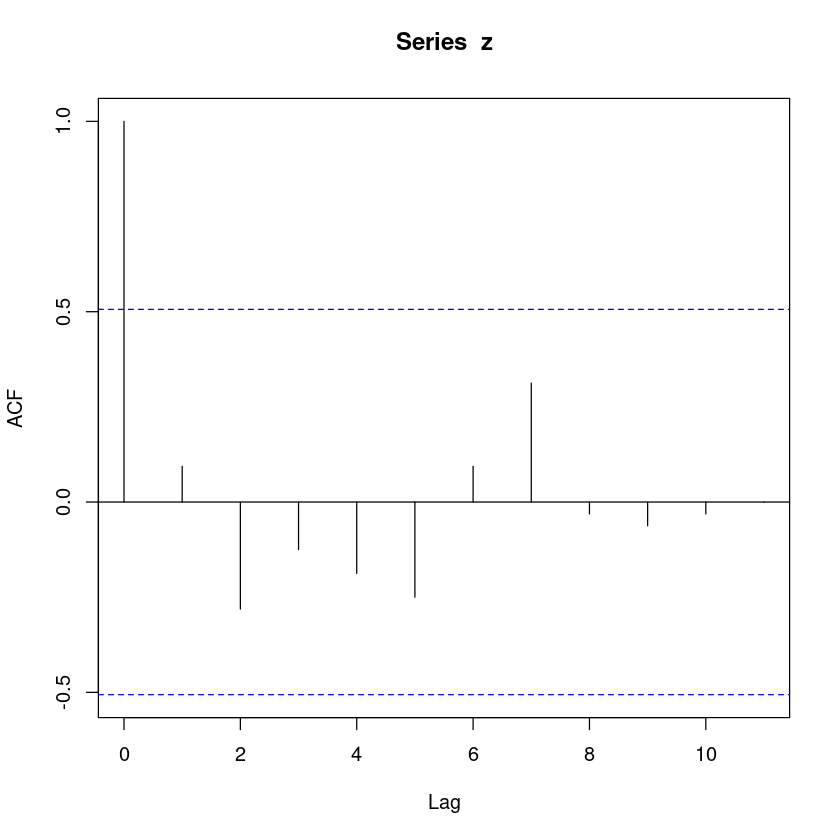
n=15
1.96*1/sqrt(n)rho1rho1 > 1.96*1/sqrt(n)rho2rho2 > 1.96*1/sqrt(n)rho3rho3 > 1.96*1/sqrt(n)rho1, rho2, rho3가 값보다 작으므로 기각할수 없다. 즉, rho=0이다.
2
다음의 모형들에 의해 설명되는 확률과정 \(\{Z_t\}\)는 정상성을 갖는가? 단 \(ε_t ∼ W N(0, 1)\).
- 정상성 만족하기 위해서는
\(E(Z_t) = \mu\)
\(Var(Z_t) = \sigma^2\)
\(Cov(Z_t,Z_{t+h}) = \gamma_h\)
(1)
\(Z_t = ε_t − ε_{t−1} − ε_{t−2}\)
\(E(Z_t) = E(ε_t − ε_{t−1} − ε_{t−2}) = E(ε_t)-E(ε_{t-1}) - E(ε_{t-2}) = 0\)
\(Var(Z_t) = Var(ε_t − ε_{t−1} − ε_{t−2}) = Var(ε_t)+Var(\epsilon_{t-1}) + Var(ε_{t−2}) = 1+1+1=3\)
- \(\epsilon_t\)는 WN이므로 \(Cov(\epsilon_t, \epsilon_{t+h})=0\)
\(Cov(Z_t,Z_{t-h}) = Cov(ε_t - ε_{t-1} - ε_{t-2}, ε_{t-h} - ε_{t-h-1} - ε_{t-h-2})\)
- \(\epsilon\)은 WN이므로 각각 COV취해줄 수 있꼬,, 상수값 나오니까 정상 시계열 조건을 만족한다.
(2)
\(Z_t = ε_tε_{t−1} + ε_{t−2}\)
-> 정상시계열
\(E(Z_t) = 0\)
\(Var(Z_t) = V(\epsilon_t \epsilon_{t-1} + \epsilon_{t-2}) = Var(\epsilon_{t-1} \epsilon_{t-2} + \epsilon_{t-3}) = V(Z_{t-1})\)
\(Var(Z_t) = Var(Z_{t-1}) = Var(Z_{t-2})= \dots\)
\(cov(Z_t, Z_{t-1}) = cov(Z_{t-1}, Z_{t-2})\)
(3)
\(Z_t = A sin \left( \dfrac{2}{3} πt + U \right)\), 단 A는 평균이 0이고 분산이 1인 확률변수이고, \(U\) 는 상수이다.
# 필요한 라이브러리 불러오기
library(ggplot2)
# 시뮬레이션을 위한 난수 시드 설정
set.seed(123)
# 시뮬레이션 횟수
n <- 100
# A는 평균이 0이고 분산이 1인 확률변수
A <- rnorm(n, mean = 0, sd = 1)
# U는 상수
U <- 2
# 시뮬레이션된 데이터 생성
t <- seq(1, n, by = 1)
Z <- A * sin((2/3) * pi * t + U)
# 생성된 데이터 시각화
ggplot(data.frame(t, Z), aes(x = t, y = Z)) +
geom_line() +
labs(title = "Simulation of Z_t", x = "Time (t)", y = "Z_t")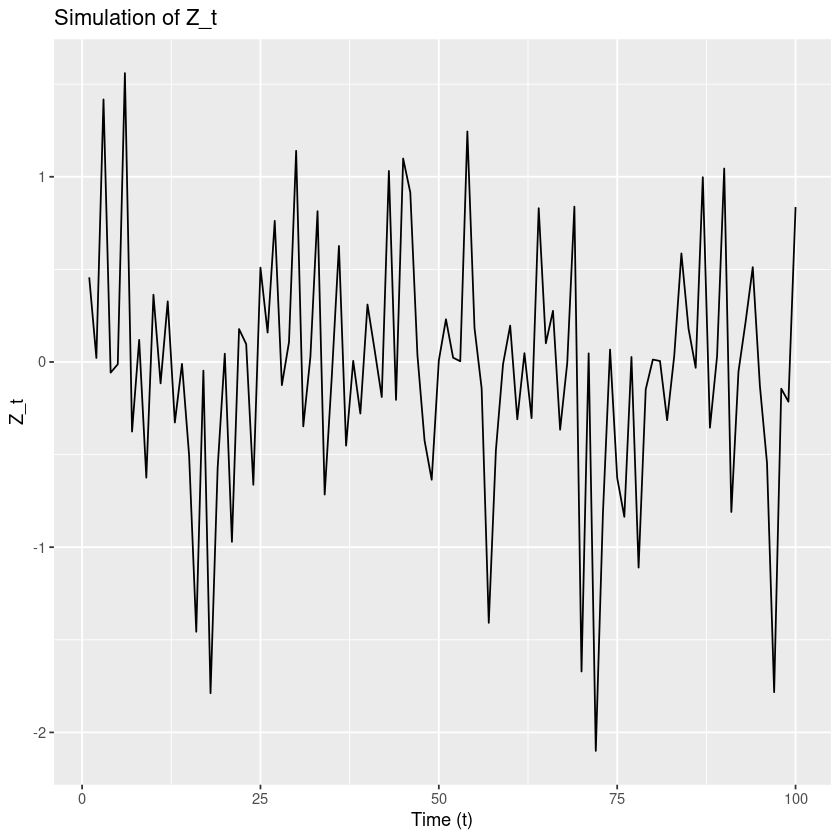
제시된 시계열 모형인 [Z_t = A (t + U)]에 대해서 정상성을 검토해보겠습니다.
주어진 모형에서 (A)는 평균이 0이고 분산이 1인 확률변수이고, (U)는 상수입니다.
- 평균 확인: [E(Z_t) = E(A (t + U))]
확률변수 (A)의 평균은 0이므로, [E(Z_t) = 0]
평균이 0이므로 평균 조건은 만족합니다.
- 분산 확인: [Var(Z_t) = Var(A (t + U))]
확률변수 (A)의 분산이 1이므로, [Var(Z_t) = Var((t + U))]
사인 함수의 범위는 -1에서 1이므로 분산은 1을 초과하지 않습니다.
[Var(Z_t) ]
분산이 상수인 경우이므로 분산 조건도 만족합니다.
- 공분산 확인: [Cov(Z_t, Z_{t-h}) = Cov(A (t + U), A ((t-h) + U))]
두 사인 함수는 서로 독립적이므로 공분산은 0입니다.
[Cov(Z_t, Z_{t-h}) = 0]
결론적으로, 주어진 시계열 모형도 평균과 분산이 상수이고, 공분산이 시간에 독립적이므로 정상성을 만족합니다.
(4)
\(Z_t = A sin (πt + U)\), 단 \(A\)는 평균이 0이고 분산이 1인 확률변수이고, \(U\) 는 \([−π, π]\)에서의 균등분포(uniform distribution)을 따르는 확률변수이다. \(A, U\) 는 서로 독립.
# 필요한 라이브러리 불러오기
library(ggplot2)
# 시뮬레이션을 위한 난수 시드 설정
set.seed(123)
# 시뮬레이션 횟수
n <- 100
# A는 평균이 0이고 분산이 1인 확률변수
A <- rnorm(n, mean = 0, sd = 1)
# U는 [-π, π]에서 균등분포를 따르는 확률변수
U <- runif(n, min = -pi, max = pi)
# 시뮬레이션된 데이터 생성
t <- seq(1, n, by = 1)
Z <- A * sin(pi * t + U)
# A는 평균이 0이고 분산이 1인 확률변수
set.seed(1)
A <- rnorm(n, mean = 0, sd = 1)
# U는 [-π, π]에서 균등분포를 따르는 확률변수
U <- runif(n, min = -pi, max = pi)
# 시뮬레이션된 데이터 생성
t <- seq(1, n, by = 1)
Z <- A * sin(pi * (t) + U)
Z1 <- A * sin(pi * (t+4) + U)set.seed(1)
cov(Z, Z1)set.seed(1)
cov(Z, Z1)(5)
\(\begin{cases} Z_{t} = \epsilon_t & t: \text{짝수} \\ Z_{t}=\epsilon_t + 1 &t: \text{홀수} \end{cases}\)
평균 0 분산 1
# 공분산을 계산할 함수 정의
calculate_covariance <- function(t) {
if (t %% 2 == 0) {
# 짝수 시점
cov_result <- 0 # 독립이므로 공분산은 0
} else {
# 홀수 시점
cov_result <- cov(rnorm(1000), rnorm(1000)) # 예시로 1000개의 샘플을 이용해 공분산 계산
}
return(cov_result)
}
# t가 홀수일 때
t_odd <- 3
cov_odd <- calculate_covariance(t_odd)
print(paste("Cov(Z_", t_odd, ", Z_", t_odd-1, "):", cov_odd))
# t가 짝수일 때
t_even <- 4
cov_even <- calculate_covariance(t_even)
print(paste("Cov(Z_", t_even, ", Z_", t_even-1, "):", cov_even))[1] "Cov(Z_ 3 , Z_ 2 ): 0.0114340797519376"
[1] "Cov(Z_ 4 , Z_ 3 ): 0"# 시뮬레이션을 위한 함수 정의
simulate_Z <- function(n) {
epsilon <- rnorm(n)
Z <- numeric(n)
for (t in 1:n) {
if (t %% 2 == 0) {
Z[t] <- epsilon[t]
} else {
Z[t] <- epsilon[t] + 1
}
}
return(Z)
}
# 시뮬레이션 데이터 생성
set.seed(1)
n <- 100
Z <- simulate_Z(n)
# 시계열 그래프 그리기
plot(1:n, Z, type = "o", col = "blue", xlab = "t", ylab = "Z_t", main = "Time Series: Z_t")
abline(h = 0, lty = 2, col = "red") # y = 0에 대한 가로선
abline(h = 1, lty = 2, col = "green") # y = 1에 대한 가로선
legend("topright", legend = c("Z_t"), col = "blue", lty = 1, cex = 0.8)
# epsilon(Z_t)를 표시
points(1:n, Z, col = "red", pch = 16)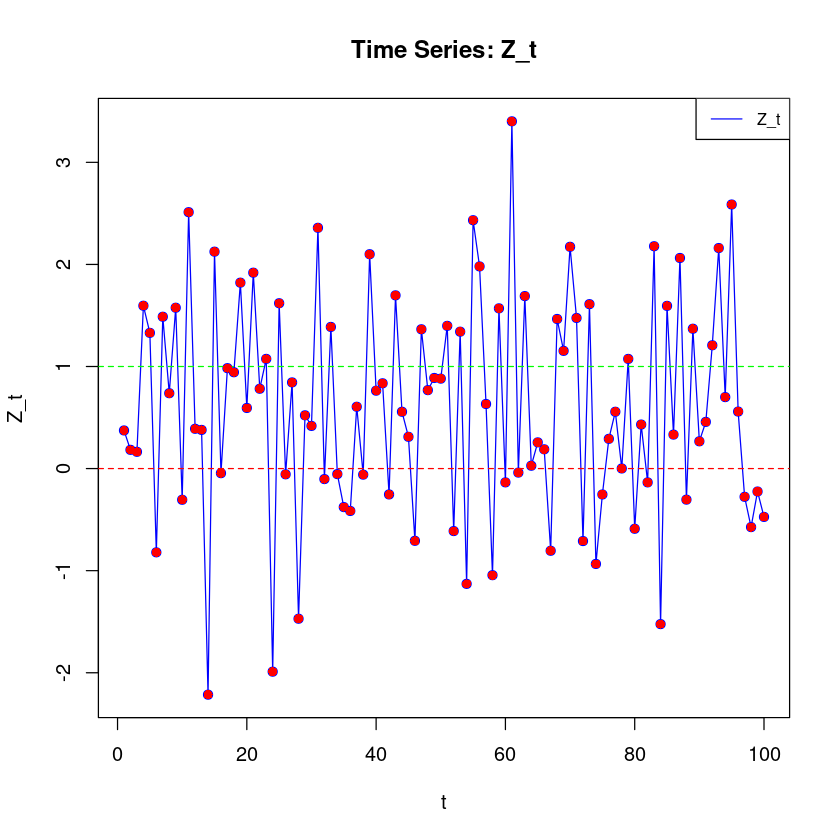
acf(Z)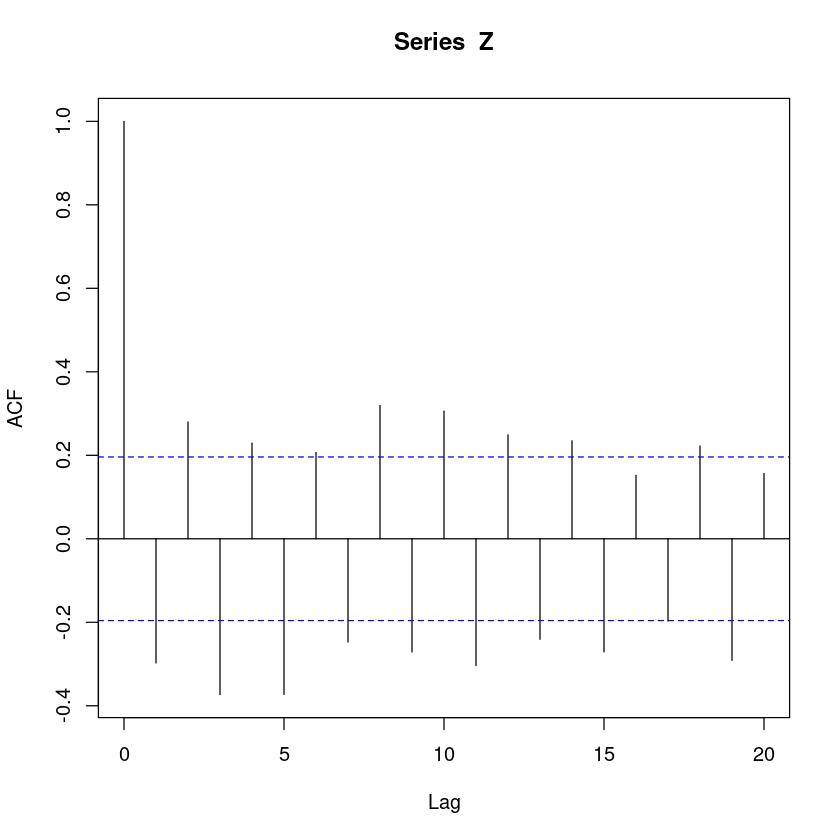
pacf(Z)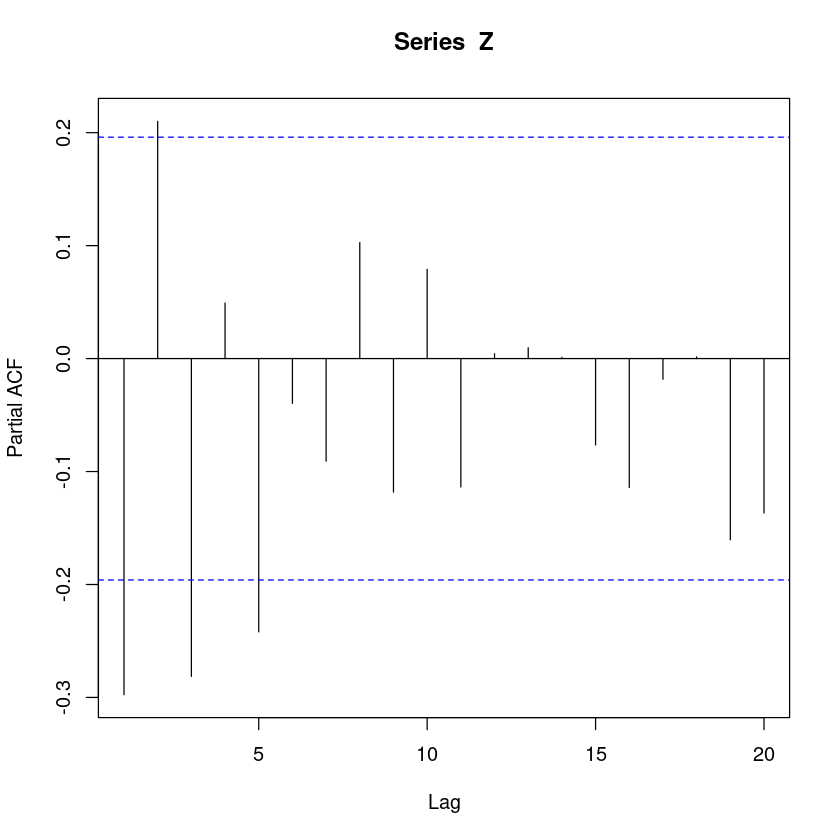
3
\(ε_t\)가 \(WN(0, σ^2)\)를 따를 때, 다음과 같은 확률과정 모형에 대하여 각 물음에 답하여라
\[Z_t − 0.8Z_{t−1} = ε_t\]
(1)
모형을 \(ϕ(B)(Z_t − µ) = θ(B)ε_t\)로 표현하고, \(ϕ(B), θ(B)\) 그리고 \(µ\)를 명시하여라.
\((1-0.8B)Z_t = \epsilon_t\)
\(\mu-0.8\mu = 0 \rightarrow \mu = 0\)
\(ϕ(B)=1-0.8B\)
\(\theta(B) = 1\)
\(\mu=0\)
(2)
모형은 AR(p), MA(q) 혹은 ARMA(p, q)모형 중 어느 것인가? p와 q도 함께 명시하여라.
AR(1)
(3)
ACF \(ρ_k, k = 1, . . . , 5\)를 계산하여라.
\(lag=0, Cov(Z_t,Z_t)\) 를 구하자.
\(\gamma_0 = [1+0.8^2 +0.8^4 +\dots ] \sigma^2=\dfrac{\sigma^2}{1-0.8^2}\)
\(lag=1\)
| \(\epsilon_t\) | \(\epsilon_{t-1}\) | \(\epsilon_{t-2}\) | \(\dots\) | |
|---|---|---|---|---|
| \(Z_t\) | 1 | 0.8 | \(0.8^2\) | \(\dots\) |
| \(Z_{t-1}\) | 0 | 1 | 0.8 | \(\dots\) |
\(\gamma_1 = [0+0.8 + 0.8^3 + \dots] \sigma^2 = \dfrac{0.8 \sigma^2}{1-0.8^2}\)
즉
\(\gamma_0 = \dfrac{\sigma^2}{1-0.8^2}\)
\(\gamma_1 = \dfrac{0.8\sigma^2}{1-0.8^2}\)
\(\gamma_2 = \dfrac{0.8^2\sigma^2}{1-0.8^2}\)
\(\gamma_3 = \dfrac{0.8^3\sigma^2}{1-0.8^2}\)
\(\gamma_4 = \dfrac{0.8^4\sigma^2}{1-0.8^2}\)
\(\gamma_5 = \dfrac{0.8^5\sigma^2}{1-0.8^2}\)
\(\rho_k = \dfrac{\gamma_k}{\gamma_0}\)
\(\rho_1 = \dfrac{\gamma_1}{\gamma_0}=0.8\)
\(\rho_2 = \dfrac{\gamma_2}{\gamma_0}=0.8^2\)
\(\rho_3 = \dfrac{\gamma_3}{\gamma_0}=0.8^3\)
\(\rho_4 = \dfrac{\gamma_4}{\gamma_0}=0.8^4\)
\(\rho_5 = \dfrac{\gamma_5}{\gamma_0}=0.8^5\)
(4)
PACF \(ϕ_{kk}, k = 1, . . . , 5\)를 계산하여라.
\(ϕ_{11}=\rho_1 = 0.8\)
AR(1)모형이므로 \(k \geq 2\)이면 \(ϕ_{kk}=0\)이다.
(5) 다시…
위에서 구한 \(ρ_k, ϕ_{kk}\) 의 상관도표를 그려라
##AR(1) phi=0.8
z <- arima.sim(n=1000, ##order=c(p,d,q) ARMA : d=0, AR : d=q=0
list(order=c(1,0,0), ar= 0.8), #ar=ϕ1
rand.gen = rnorm,
sd = sqrt(1)) #분산
forecast::tsdisplay(z, lag.max=24)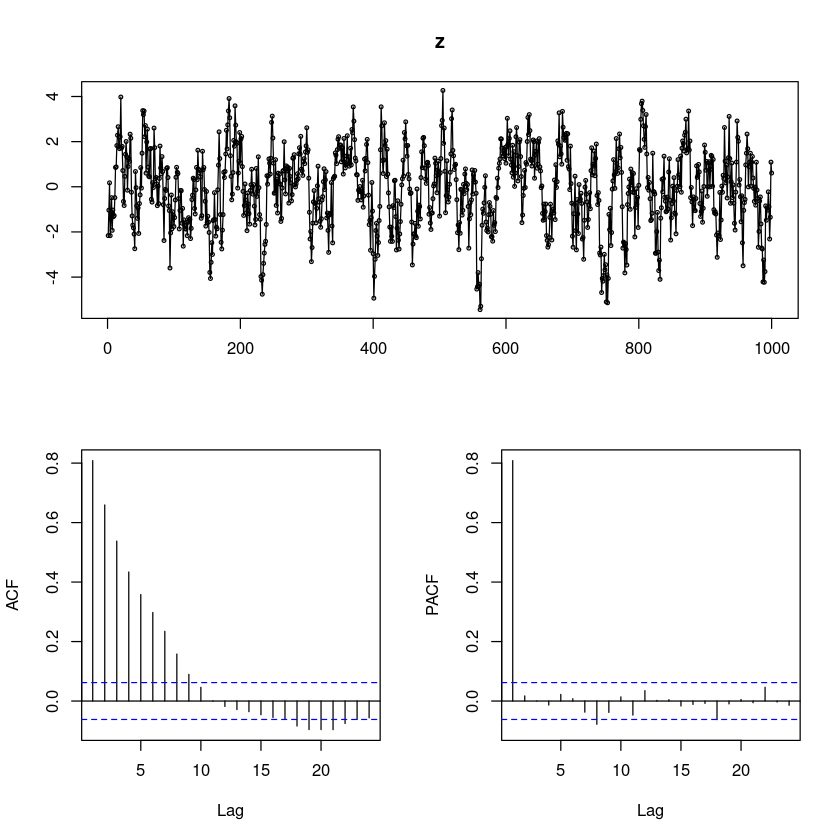
ACF그림은 지수적으로 감소하는 형태이고.
PACF는 h=1에서만 값이 존재하고 나머지는 다 0이다
4
다음의 모형에 대하여 다음 물음에 답하여라.
\[Z_t = ε_t − θ_1ε_{t−1} − θ_2ε_{t−2}, ε_t ∼ W N(0, σ^2)\]
(1)
자기상관함수(ACF) \(ρ_h, h = 1, 2, . . .\)를 구하시오.
\(\gamma_k = Cov(Z_t, Z_{t-k}) = E[(ε_t − θ_1ε_{t−1} − θ_2ε_{t−2})(ε_{t-1} − θ_1ε_{t−2} − θ_2ε_{t−3})]\)
lag=0
\(\gamma_0 = (1+\theta_1^2 + \theta_2^2)\)
| 1 | - theta_1 | - theta_2 |
|---|---|---|
| 1 | - theta_1 | - theta_2 |
lag=1
\(\gamma_1 =-\theta_1 + \theta_1 \theta_2\)
| 1 | - theta_1 | - theta_2 |
|---|---|---|
| – | 1 | - theta_1 |
lag2
\(\gamma_2 = -\theta_2\)
| 1 | -theta_1 | - theta_2 |
|---|---|---|
| – | – | 1 |
\(\rho_1 = \dfrac{\rho_1}{\rho_0} = \dfrac{-\theta_1 + \theta_1 \theta_2}{1+\theta_1^2 + \theta_2^2}\)
\(\rho_2 = \dfrac{\rho_2}{\rho_0} = \dfrac{-\theta_2}{1+\theta_1^2 + \theta_2^2}\)
- MA(2)모형이므로 k가 3이상이면 acf값은 다 0이다
(2)
부분자기상관함수(PACF) \(ϕ_{11}, ϕ_{22}\)를 구하시오.
\(ϕ_{11}=\rho_1 = \dfrac{-\theta_1 + \theta_1 \theta_2}{1+\theta_1^2 + \theta_2^2}\)
\(ϕ_{22} = \dfrac{\rho_2 - \rho_1^2}{1-\rho_1^2}\)
계싼복잡…생략..
5
\(ε_t\) 가 \(WN(0, σ^2)\)를 따를 때, 다음과 같은 확률과정의 모형들에 대하여 각 물음에 답하여라. (단, (3)-(5)는 R을 이용하여, 각 모형을 따르는 10000개의 데이터를 생성한 후, acf, pacf 함수를 이용 한다.)
모형 1 : \(Z_t − 9.5 = ε_t − 1.3ε_{t−1} + 0.6ε_{t−2}\)
모형 2 : \(Z_t − 0.6Z_{t−1} = 38 + ε_t + 0.9ε_{t−1}\)
모형 3 : \(Z_t = 26 + 0.6Z_{t−1} + ε_t + 0.2ε_{t−1} + 0.5ε_{t−2}\)
모형 4 : \(Z_t − 1.5Z_{t−1} + 0.7Z_{t−2} = 100 + ε_t − 0.5ε_{t−1}\)
(1)
모형을 \(ϕ(B)(Z_t − µ) = θ(B)ε_t\)로 표현하고, \(ϕ(B), θ(B)\) 그리고 \(µ\)를 명시하여라.
모형1
\((Z_t-9.5) = (1-1.3B + 0.6 B^2)\epsilon_t\)
\(ϕ(B)=1, θ(B)=(1-1.3B + 0.6 B^2), \mu=9.5\)
모형2
\((1-0.6B)(Z_t - \mu) = (1+0.9B)\epsilon_t\)
\(\mu - 0.6 \mu = 38 \rightarrow \mu=38/0.4\)
모형3
\((1-0.6B)(Z_t-\mu) = (1+0.2B +0.8B^2)\epsilon_t\)
\(ϕ(B)=1-0.6B, θ(B)=(1+0.2B +0.8B^2)\)
\(\mu-0.6\mu = 26 \rightarrow 0.4\mu = 26 \rightarrow \mu = 26/0.4=65\)
모형4
\((1-1.5B+0.7B^2)(Z_t-\mu) = (1-0.5B)\epsilon_t\)
\(\mu - 1.5\mu + 0.7 \mu =100\)
\(\mu=500\)
(2)
모형은 AR(p), MA(q) 혹은 ARMA(p, q)모형 중 어느 것인가? p와 q도 함께 명시하여라.
모형1 : MA(2)
모형2 : ARMA(1,1)
모형3 : ARMA(1,2)
모형4 : ARMA(2,1)
(5)
위에서 구한 \(ρ_k, ϕ_{kk}\) 의 상관도표를 그려라
모형1
z1 <- arima.sim(n=10000,
list(order=c(0,0,2), ma=c(1.3, -0.6)))
forecast::tsdisplay(z1, lag.max=24)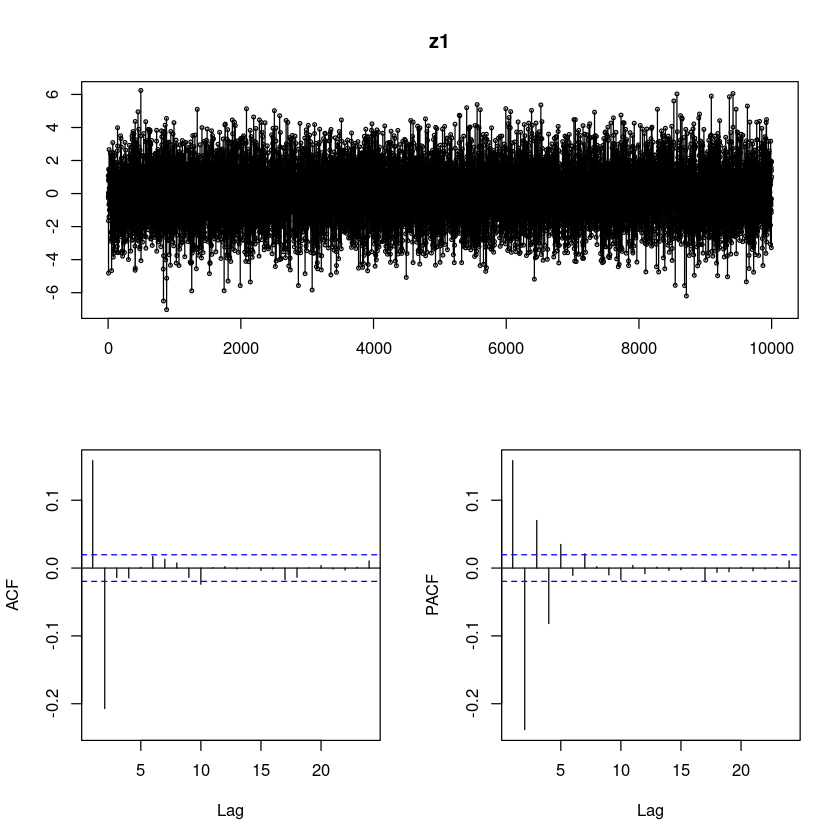
모형2
z2 <- arima.sim(n=10000,
list(order=c(1,0,1), ar=0.6, ma=0.9),
rand.gen = rnorm)
forecast::tsdisplay(z2, lag.max=24)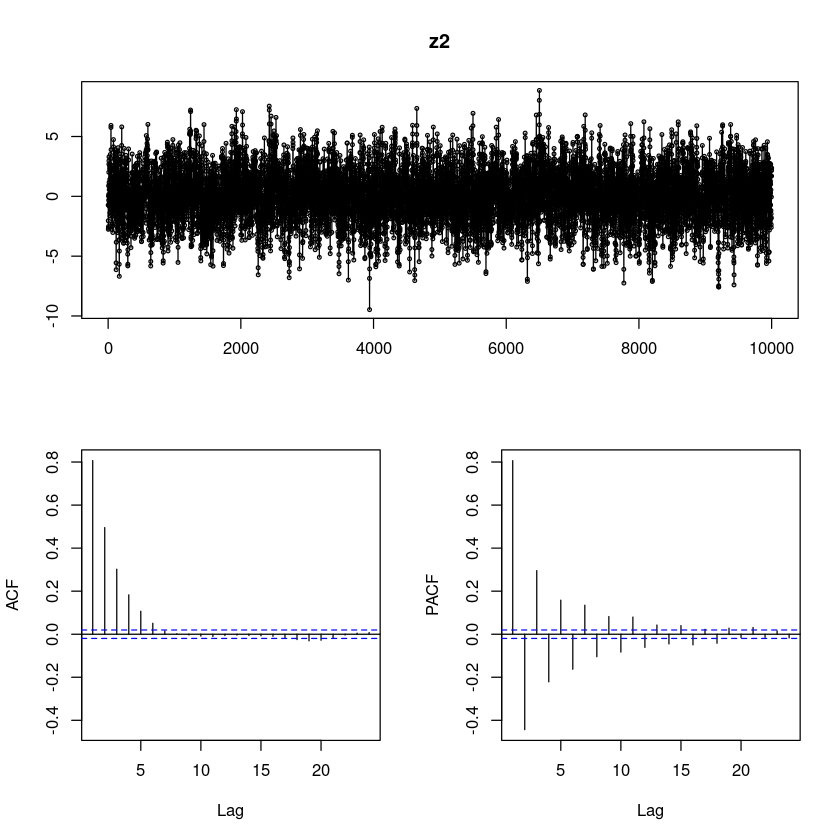
모형3
z3 <- arima.sim(n=10000,
list(order=c(1,0,2), ar=0.6, ma=c(0.2,0.5)),
rand.gen = rnorm)
forecast::tsdisplay(z3, lag.max=24)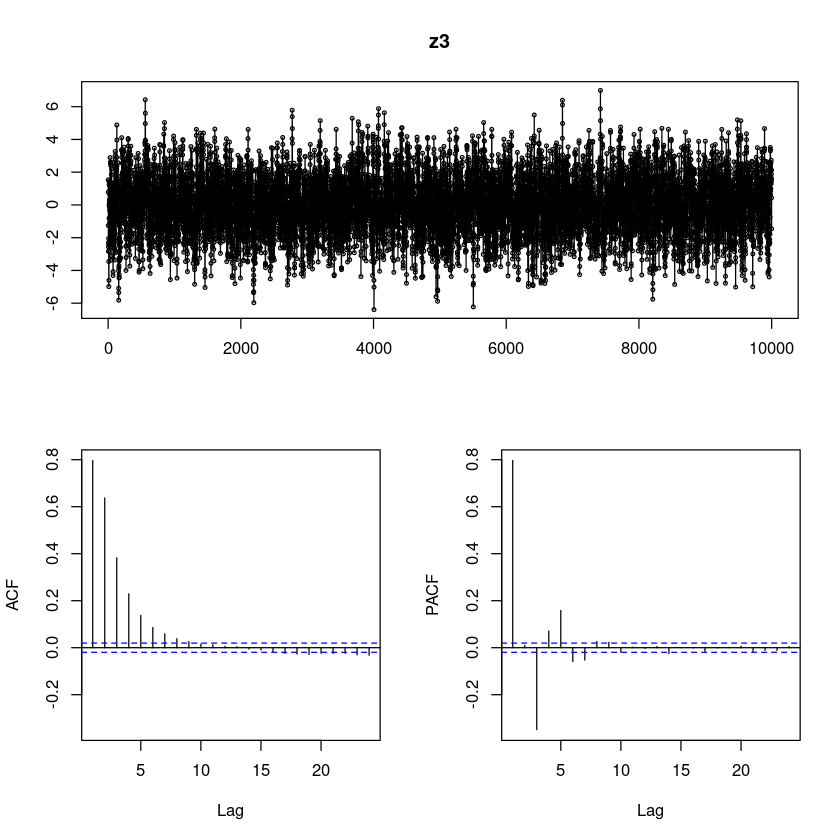
모형4
z4 <- arima.sim(n=10000,
list(order=c(2,0,1), ar=c(1.5,-0.7), ma=-0.5),
rand.gen = rnorm)
forecast::tsdisplay(z4, lag.max=24)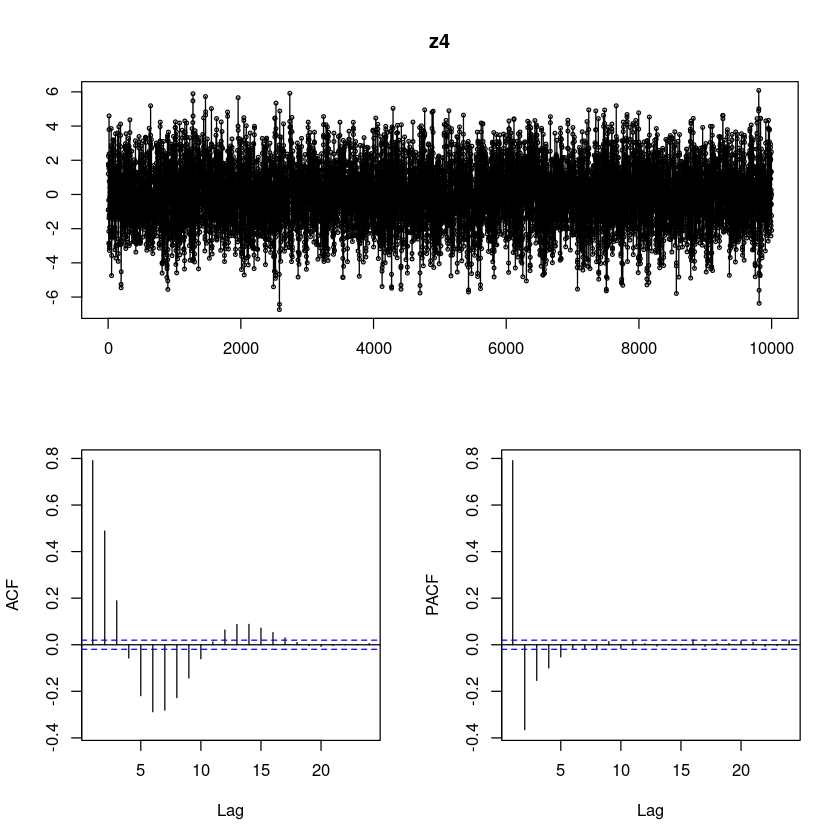
(3)
ACF \(ρ_k, k = 1, . . . , 10\)를 계산하여라.
모형1
acf_z1<-acf(z1,plot=FALSE)
acf_z1[1:10]
Autocorrelations of series ‘z1’, by lag
1 2 3 4 5 6 7 8 9 10
0.158 -0.207 -0.014 -0.015 0.001 0.017 0.013 0.008 -0.014 -0.024 모형2
acf_z2<-acf(z2,plot=FALSE)
acf_z2[1:10]
Autocorrelations of series ‘z2’, by lag
1 2 3 4 5 6 7 8 9 10
0.807 0.495 0.302 0.183 0.107 0.051 0.015 0.002 -0.003 -0.009 모형3
acf_z3<-acf(z3,plot=FALSE)
acf_z3[1:10]
Autocorrelations of series ‘z3’, by lag
1 2 3 4 5 6 7 8 9 10
0.796 0.637 0.382 0.229 0.138 0.086 0.059 0.038 0.027 0.016 모형4
acf_z4<-acf(z4,plot=FALSE)
acf_z4[1:10]
Autocorrelations of series ‘z4’, by lag
1 2 3 4 5 6 7 8 9 10
0.791 0.488 0.189 -0.057 -0.219 -0.288 -0.281 -0.227 -0.143 -0.060 (4)
PACF \(ϕ_{kk}, k = 1, . . . , 10\)를 계산하여라.
모형1
pacf_z1<-pacf(z1,plot=FALSE)
pacf_z1[1:10]
Partial autocorrelations of series ‘z1’, by lag
1 2 3 4 5 6 7 8 9 10
0.158 -0.238 0.070 -0.082 0.035 -0.011 0.021 0.002 -0.010 -0.017 모형2
pacf_z2<-pacf(z2,plot=FALSE)
pacf_z2[1:10]
Partial autocorrelations of series ‘z2’, by lag
1 2 3 4 5 6 7 8 9 10
0.807 -0.443 0.296 -0.221 0.158 -0.163 0.135 -0.105 0.082 -0.083 모형3
pacf_z3<-pacf(z3,plot=FALSE)
pacf_z3[1:10]
Partial autocorrelations of series ‘z3’, by lag
1 2 3 4 5 6 7 8 9 10
0.796 0.010 -0.349 0.071 0.158 -0.059 -0.052 0.026 0.023 -0.019 모형4
pacf_z4<-pacf(z4,plot=FALSE)
pacf_z4[1:10]
Partial autocorrelations of series ‘z4’, by lag
1 2 3 4 5 6 7 8 9 10
0.791 -0.365 -0.153 -0.099 -0.052 -0.016 -0.017 -0.021 0.013 -0.017 6
다음과 같은 ACF를 갖는 가역성 조건을 만족하는 MA(1)과정의 모형을 구하라.
\[ρ_0 = 0, ρ_1 = \dfrac{1}{9} , ρ_k = 0, k ≥ 0\]
\(Z_t = \epsilon_t + \theta \epsilon_{t-1}\)
\(acf(1) = \dfrac{\gamma_1}{\gamma_2} = \dfrac{\theta}{1+\theta^2} = \dfrac{1}{9}\)
\(\theta^2 - 9 \theta + 1 = 0\)
\(\theta = \dfrac{9 +- \sqrt{77}}{2}\)
\(\therefore \theta = \dfrac{9 - \sqrt{77}}{2}\)
7
(R실습). 확률과정 \(Z_t = 1 + 0.9Z_{t−1} + ε_t, t = 1, 2, . . . , 100\)으로부터 시계열 자료를 생성한 후 다음을 수행하라. 단 \(Z_0 = 10\)의 값을 주고 \(ε_t\)는 \(ε_t\) \(∼_{i.i.d.} N(0, 1)\)이다.
(1)
\(\{Z_t\}\)의 시계열그림을 그려라.
zt<-c()
zt[1]<-1+0.9*10+rnorm(1)
for(i in 2:100) zt[i]<-1+0.9*zt[i-1]+rnorm(1)
zt- 11.6339448027521
- 10.0297491611439
- 10.48063483597
- 9.93642780128935
- 12.10806261555
- 10.2152209396991
- 13.7460677185397
- 12.4263586349121
- 14.2456440350337
- 13.8729153099666
- 13.8890374145228
- 13.9096357199169
- 11.8863371309684
- 12.9440758775657
- 13.5247886391223
- 12.7296586313629
- 11.4648254531922
- 11.283064858838
- 11.8156929303286
- 11.7448658878451
- 12.32448262803
- 13.1115048005427
- 13.8239208468079
- 11.3770837195393
- 12.3094831568635
- 12.7681316908829
- 11.1969801637485
- 11.7850096742986
- 12.0017396538599
- 10.6792160011758
- 11.2148693275543
- 10.6308609660893
- 9.91138476326052
- 10.621892845388
- 10.4522213240463
- 9.20987208077002
- 9.58604819929471
- 10.1583427398488
- 10.2700295381873
- 9.71201245009552
- 9.44366007729987
- 10.4158409321234
- 8.5872299494766
- 9.78917635247713
- 10.8963137494163
- 12.2103678903036
- 9.86578693146142
- 9.22172683986994
- 9.25190651171671
- 9.77490401630087
- 8.39829231775574
- 8.02288161790795
- 9.33096801713232
- 10.5626886258504
- 12.2178435406066
- 10.8323714373393
- 9.33311061289182
- 8.75520751151145
- 6.99380448839169
- 8.30691924800892
- 7.31415617895965
- 8.60162312019057
- 8.66022818106746
- 8.80057388980463
- 9.0651181702265
- 10.3675019024102
- 10.459871851365
- 9.48213366411919
- 10.4384121274965
- 11.2615099419654
- 11.4697170638735
- 10.0056820675572
- 10.2359996396427
- 11.4242893053008
- 12.6602103679228
- 12.7574603409234
- 11.8908574765488
- 11.1575316713236
- 12.0110929132003
- 11.9939485154955
- 12.4728230524616
- 10.2075419571772
- 9.38962144084908
- 10.4548676710282
- 9.72979326504712
- 11.2340144963607
- 11.3405372075702
- 9.80425419934968
- 8.20459976095349
- 8.20525882325441
- 7.26026421509633
- 5.76925419364217
- 6.41193936626902
- 6.62448446575856
- 7.46042237514119
- 5.42011565691056
- 6.02517355061036
- 6.41190471763322
- 7.87428239163398
- 8.70956639743375
plot(zt)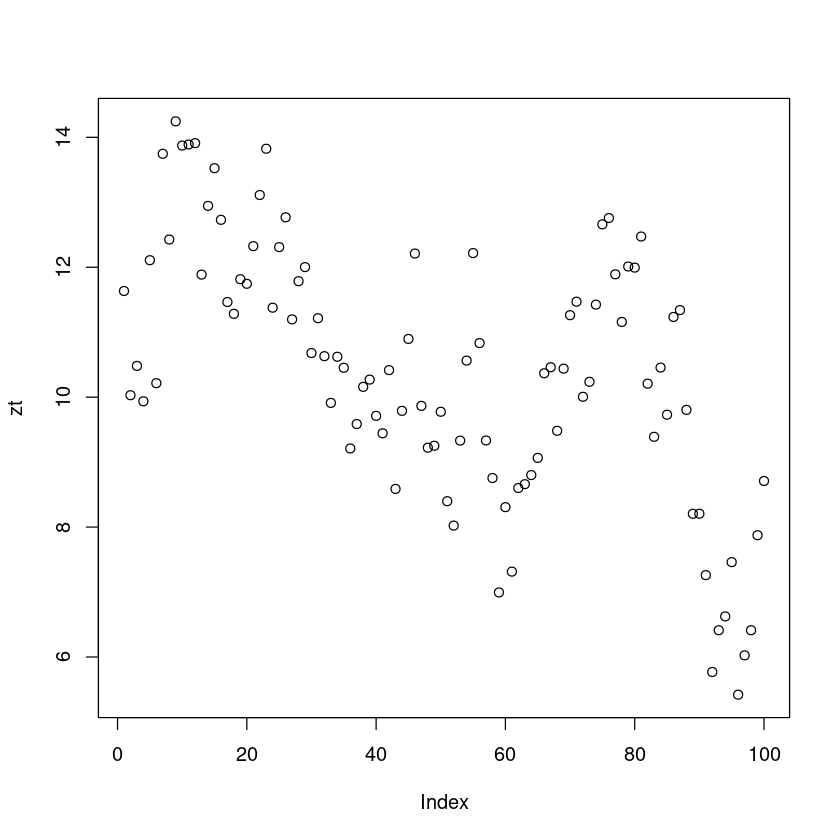
(2)
SACF, \(\hatρ_h, h = 1, 2, . . . , 10\)을 구하여 표본상관도표를 그려라
acf(zt)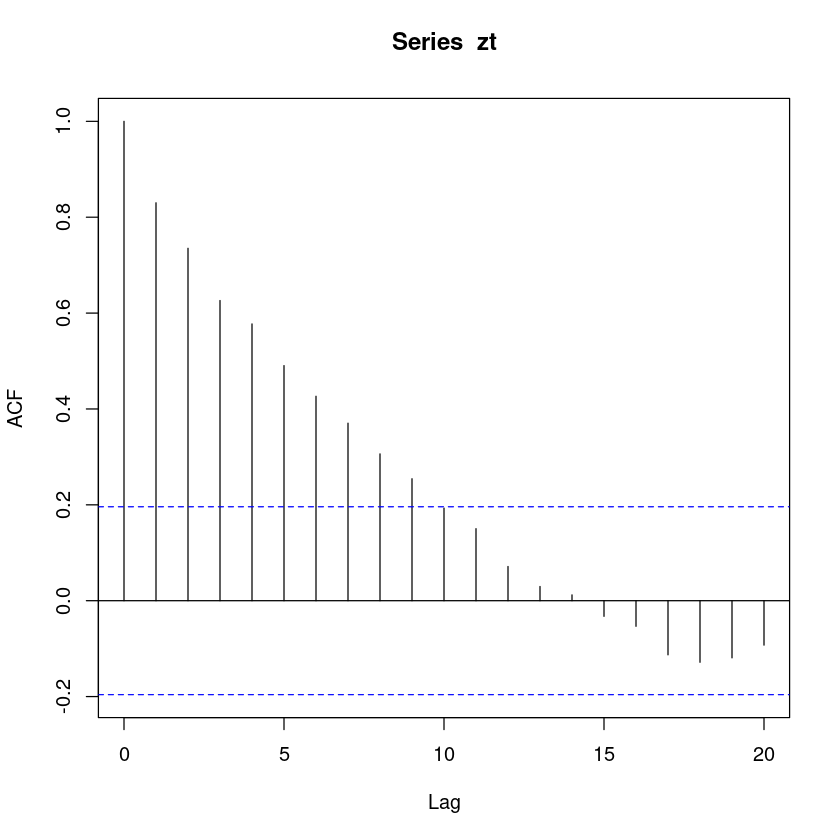
acf(zt)$acf- 1
- 0.830045823110411
- 0.735129876073393
- 0.62619795113663
- 0.577356281418996
- 0.490427164682597
- 0.42649296433039
- 0.370321611649739
- 0.306248799055932
- 0.254412017586095
- 0.193156199329482
- 0.150250566238672
- 0.0713563901629154
- 0.029639995485257
- 0.0121346208843998
- -0.0325772325466221
- -0.0533571962757925
- -0.112886388416267
- -0.128414978937425
- -0.119157092402368
- -0.0926266728203544
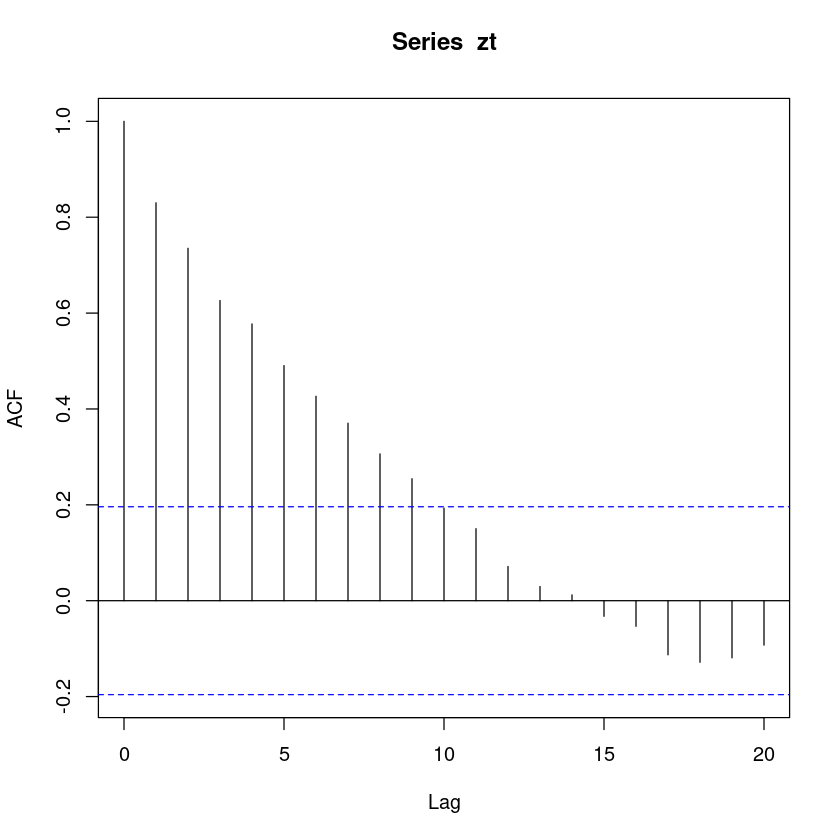
(3)
SPACF, \(\hat ϕ_{kk}, k = 1, 2, . . . , 10\)을 구하여 표본상관도표를 그려라
pacf(zt)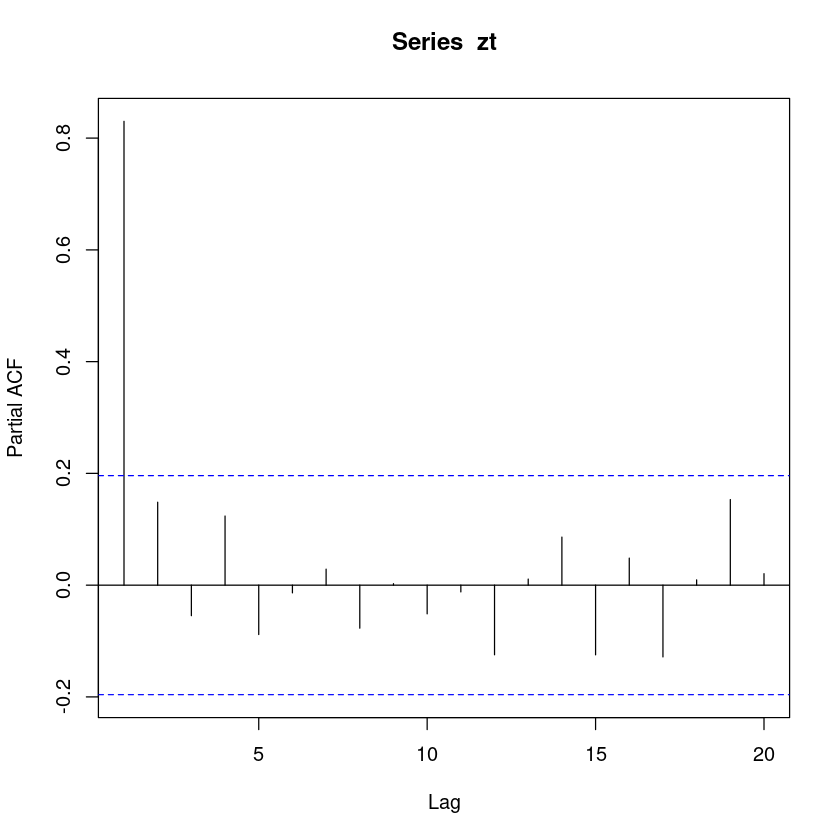
pacf(zt)$acf- 0.830045823110411
- 0.148393107187214
- -0.0546343362957735
- 0.123678558628976
- -0.0883551477937624
- -0.013798929554003
- 0.0286016292581917
- -0.0769841241329633
- 0.00263703156357633
- -0.0513306551749866
- -0.012079285174621
- -0.1246153113177
- 0.0108296561187292
- 0.0859635380334657
- -0.124685817267623
- 0.0483698221700843
- -0.128411011143925
- 0.00942969415608426
- 0.153161608224047
- 0.0205013651615918
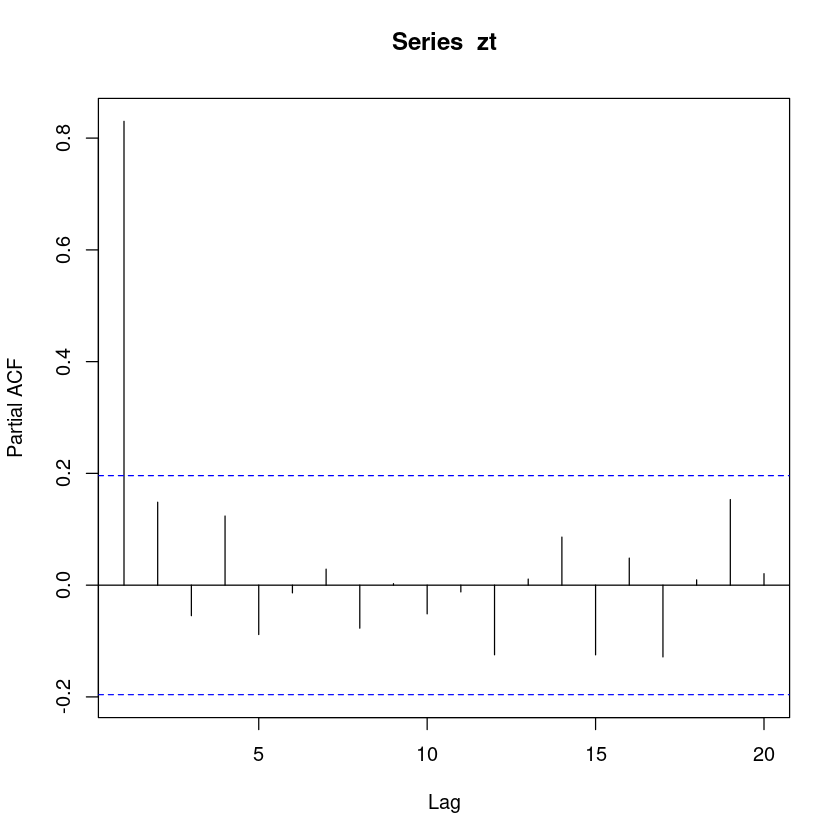
(4)
\(\{Z_t, Z_{t−1} \}\)의 산점도를 그리고, 이 산점도와 \(\hatρ_1\)의 관계를 설명하여라
plot(zt,data.table::shift(zt,-1))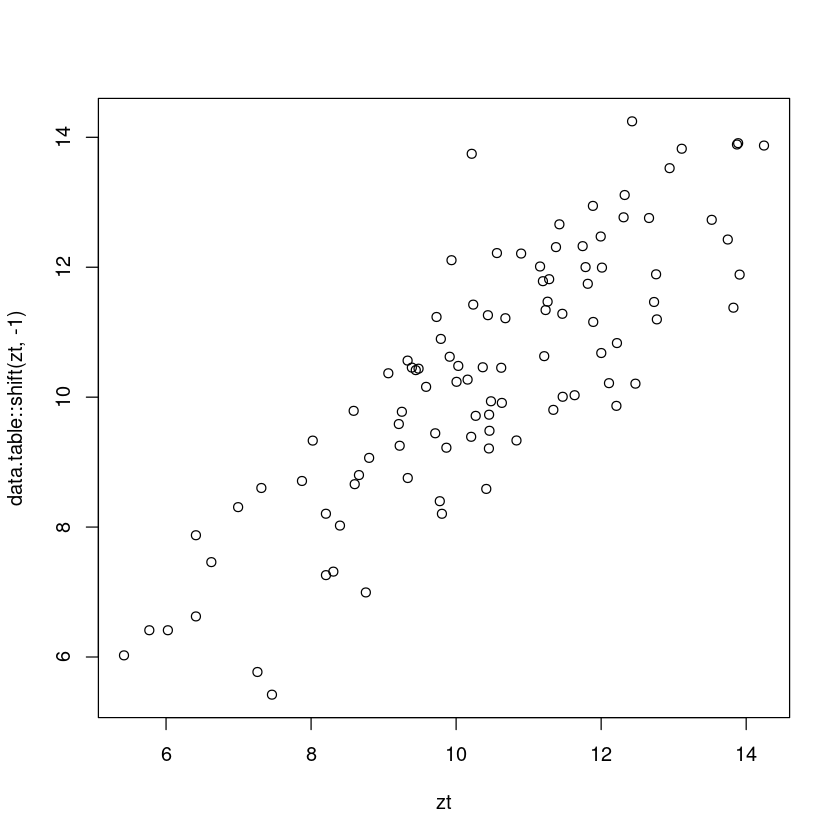
cor(zt,data.table::shift(zt,-1), use = 'pairwise.complete.obs')(5)
\(\{Z_t, Z_{t−2} \}\)의 산점도를 그리고, 이 산점도와 \(\hatρ_2\)의 관계를 설명하여라
- 10.48063483597
- 9.93642780128935
- 12.10806261555
- 10.2152209396991
- 13.7460677185397
- 12.4263586349121
- 14.2456440350337
- 13.8729153099666
- 13.8890374145228
- 13.9096357199169
- 11.8863371309684
- 12.9440758775657
- 13.5247886391223
- 12.7296586313629
- 11.4648254531922
- 11.283064858838
- 11.8156929303286
- 11.7448658878451
- 12.32448262803
- 13.1115048005427
- 13.8239208468079
- 11.3770837195393
- 12.3094831568635
- 12.7681316908829
- 11.1969801637485
- 11.7850096742986
- 12.0017396538599
- 10.6792160011758
- 11.2148693275543
- 10.6308609660893
- 9.91138476326052
- 10.621892845388
- 10.4522213240463
- 9.20987208077002
- 9.58604819929471
- 10.1583427398488
- 10.2700295381873
- 9.71201245009552
- 9.44366007729987
- 10.4158409321234
- 8.5872299494766
- 9.78917635247713
- 10.8963137494163
- 12.2103678903036
- 9.86578693146142
- 9.22172683986994
- 9.25190651171671
- 9.77490401630087
- 8.39829231775574
- 8.02288161790795
- 9.33096801713232
- 10.5626886258504
- 12.2178435406066
- 10.8323714373393
- 9.33311061289182
- 8.75520751151145
- 6.99380448839169
- 8.30691924800892
- 7.31415617895965
- 8.60162312019057
- 8.66022818106746
- 8.80057388980463
- 9.0651181702265
- 10.3675019024102
- 10.459871851365
- 9.48213366411919
- 10.4384121274965
- 11.2615099419654
- 11.4697170638735
- 10.0056820675572
- 10.2359996396427
- 11.4242893053008
- 12.6602103679228
- 12.7574603409234
- 11.8908574765488
- 11.1575316713236
- 12.0110929132003
- 11.9939485154955
- 12.4728230524616
- 10.2075419571772
- 9.38962144084908
- 10.4548676710282
- 9.72979326504712
- 11.2340144963607
- 11.3405372075702
- 9.80425419934968
- 8.20459976095349
- 8.20525882325441
- 7.26026421509633
- 5.76925419364217
- 6.41193936626902
- 6.62448446575856
- 7.46042237514119
- 5.42011565691056
- 6.02517355061036
- 6.41190471763322
- 7.87428239163398
- 8.70956639743375
- <NA>
- <NA>
plot(zt,data.table::shift(zt,-2))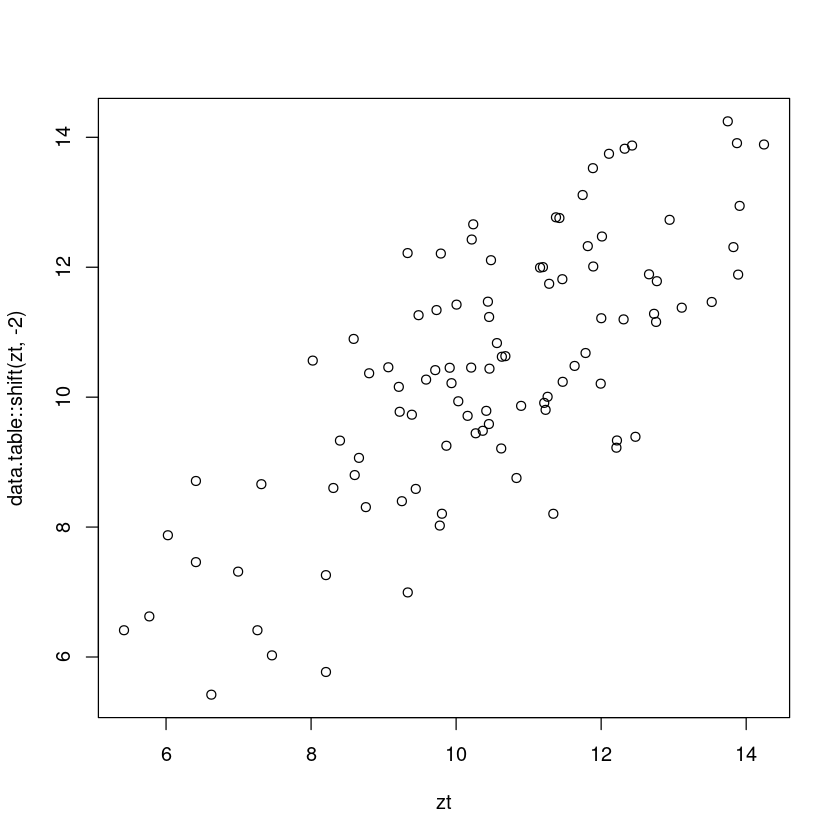
cor(zt,data.table::shift(zt,-2), use = 'pairwise.complete.obs')